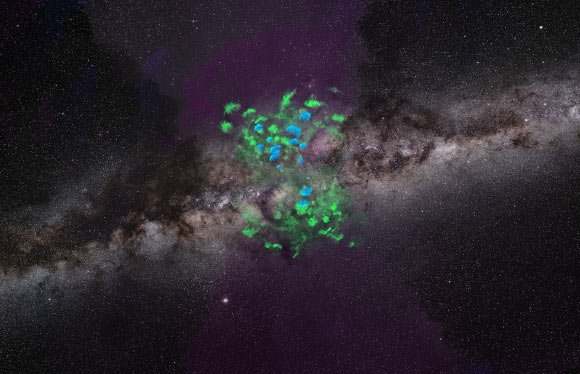Using new 21-cm radio observations made with NSF’s Green Bank Telescope, astronomers have discovered over 250 neutral gaseous clouds being blasted out of the center of our Milky Way Galaxy into interstellar space. These clouds are likely a product of the same phenomenon that created the Fermi Bubbles.
An artist’s conception of the clouds flowing out from the center of the Milky Way, entrained in a very hot wind that has accelerated them to velocities of many hundreds of km per second. Image credit: NSF / GBO / P. Vosteen.
It has been known for some time that energetic processes in the center of the Milky Way have created fast, hot winds expanding into intergalactic space with temperatures of millions of degrees and velocities of thousands of km per second. Most large galaxies have winds like this.
The accidental discovery that some of this outflowing hot gas has entrained cold hydrogen clouds was made by the Australian ATCA telescope measuring the 21-cm radio emission emitted by interstellar hydrogen atoms.
This implied that there could be an undiscovered population of clouds carrying matter out of the nucleus of the Milky Way.
The hydrogen clouds are important on their own, but they also serve as probes of the hot wind.
It is difficult to measure conditions within the very hot wind, but the cool clouds can trace it in the same way that on Earth, a handful of leaves tossed upwards can show the direction and speed of the local wind.
The sensitivity of the Green Bank Telescope (GBT) make it the ideal instrument for detecting faint signals from interstellar hydrogen, but mapping these clouds, and realizing their true extent, was no easy feat.
“It took years using the GBT to systematically map hundreds of square degrees in search of faint hydrogen emission,” said Dr. Felix James ‘Jay’ Lockman, senior astronomer at the Green Bank Observatory.
“Once we identified some promising candidates, we could follow up with targeted observations at other telescopes to show us more.”
“The clouds must have been ripped from an area near the very center of the Milky Way and flung outward, either by a burst of star formation or activity of a black hole.”
Some of these clouds have the highest outflow velocity of any clouds ever observed in the Milky Way, and may escape the Galaxy.
In an unexpected twist, the new data from the APEX telescope revealed that some of the hydrogen clouds contain molecules and dense cold gas.
“No one would have expected that clouds violently ejected from the Milky Way could harbor relatively fragile molecular material, but there it is,” Dr. Lockman said.
Astronomers using the MeerKAT array recently mapped the hydrogen in a few clouds at high angular resolution, showing them evolving and being shredded as they flow into interstellar space.
“These new results open the door for more discoveries,” Dr. Lockman said.
“How the clouds remain stable as they are accelerated to more than 400 km per second is a mystery.”
“The chemical processes in these clouds are quite unusual and unexplored.”
Dr. Lockman and his colleague, Dr. Enrico Di Teodoro from the Università degli Studi di Firenze, presented the findings at AAS243, the 243rd meeting of the American Astronomical Society in New Orleans, Louisiana, the United States.
_____
Felix Lockman & Enrico Di Teodoro. 2024. A New Census of Neutral Clouds in the Milky Way’s Nuclear Wind. AAS243, abstract #2851
Discover more from CaveNews Times
Subscribe to get the latest posts sent to your email.


























![Exploring the Serene Beauty of Nature: A Reflection on [YouTube video title]](https://cavemangardens.art/storage/2024/04/114803-exploring-the-serene-beauty-of-nature-a-reflection-on-youtube-video-title-360x180.jpg)



























